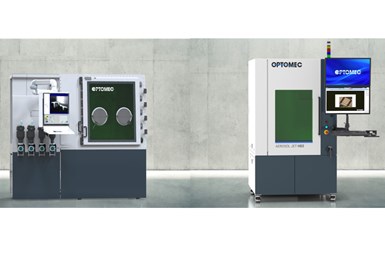Optomec Metal Printers Designed for Automated, High-Volume Production
RAPID 2021: Machines offer fully automated, high-volume production for both metal additive and 3D printed electronics.
Share
Read Next

Optomec’s HC-TBR and Aerosol Jet HD2 3D electronics printers
Optomec’s HC-TBR and Aerosol Jet HD2 3D electronics printers are specifically designed for high-volume production, incorporate automated part-handling options and designed with operator-friendly production software for error-free job sequencing in a manufacturing setting.
Optomec’s HC-TBR 3D metal printer is a compact, all-in-one metal Additive Manufacturing (AM) machine that uses Directed Energy Deposition (DED) to build or repair 3D metal parts using a wide variety of alloys. In particular, this machine is capable of processing reactive metal alloys such as titanium and aluminum, at high volume in an oxygen-free chamber to ensure superior mechanical properties, the company says.
Using advanced laser optics, the machine can remotely change the size and power profile of its laser beam, enabling significant reductions in print times. The company says this is a first for the industry. The machine was designed to lower cost methods of producing and repairing titanium components. It is said the machine can be integrated into work cells or automated production lines. With this machine, process development time is optimized when using Optomec’s turn-key process recipes to help manufacturers get up and running in weeks instead of months.
The Aerosol Jet HD2 3D electronics printer uses Optomec’s patented Aerosol Jet solution to produce high-resolution circuitry (with features as small as 10 microns), including an ability to dispense conformal 3D interconnects between die, chips, components and substrates. This interconnect approach is said to be all the more powerful due to its improved performance at high signal frequencies, enabling longer range and reduced power consumption in emerging segments such as 5G communications, automotive radar and defense applications.
As a primary application, the Aerosol Jet HD2 can serve as a drop-in replacement for the decades-old method of connecting electrical components with wire bonds, which are said to suffer from several critical deficiencies, including space inefficiency, high scrap and poor signal performance.
Related Content
-
Two 12-Laser AM Machines at Collins Aerospace: Here Is How They Are Being Used
With this additive manufacturing capacity, one room of the Collins Iowa facility performs the work previously requiring a supply chain. Production yield will nearly double, and lead times will be more than 80% shorter.
-
With Electrochemical Additive Manufacturing (ECAM), Cooling Technology Is Advancing by Degrees
San Diego-based Fabric8Labs is applying electroplating chemistries and DLP-style machines to 3D print cold plates for the semiconductor industry in pure copper. These complex geometries combined with the rise of liquid cooling systems promise significant improvements for thermal management.
-
3D Printing with Plastic Pellets – What You Need to Know
A few 3D printers today are capable of working directly with resin pellets for feedstock. That brings extreme flexibility in material options, but also requires greater knowledge of how to best process any given resin. Here’s how FGF machine maker JuggerBot 3D addresses both the printing technology and the process know-how.













